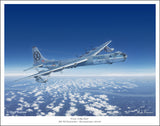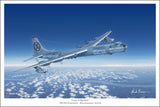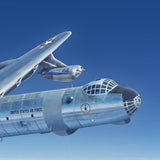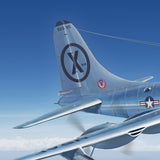First flying on August 8, 1946, the B-36 Peacemaker was developed from an early 1941 requirement for a new bomber able to reach Europe and return to bases in North America, unrefueled. After the end of WWII, with the Soviet testing of their own atomic bomb, It became the first strategic bomber of the Cold War.
Initially the B-36 was powered by six Pratt and Whitney R-4360 Wasp Major radial engines in a pusher arrangement. Beginning with the D model, a pair of General Electric J47-19 jet engines suspended near the end of each wing. B-36B models were also retrofitted with the jet engines. The aircraft was powered by a total of ten engines - six radial propeller engines and four jet engines. A common slogan for the B-36 was Six Turnin' and Four Burnin'.
The B-36 had a phenomenal range of over 4,000 miles and could carry up to 87,200 lb of bomb in its four bomb bays. It was not initially designed to carry a nuclear weapon but was able to fulfill that role when the bomb became available. The airplane was able to cruise at an altitude of 40,000+ feet which was well above the operating altitude of 1940s era fighters.
Because of its high cruising altitude, range and heavy payload capacity, the B-36 was developed into a photo reconnaissance aircraft. The RB-36D was the first model to be outfitted for the role. Beginning in 1951, with a range of 9,300 mi, RB-36D was able to investigate the Arctic boundaries of the Soviet Union. The airplane could stay aloft for 40 hours.
This artwork is a depiction of the RB-36D in flight.








